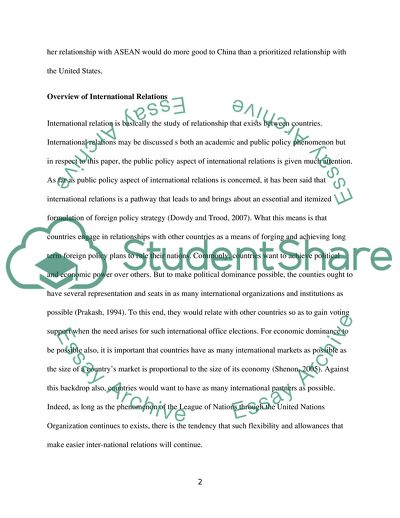Cite this document
(China and It Prioritise Improving its Relationship with the ASEAN Countries over its Relationship with the US Essay Example | Topics and Well Written Essays - 4250 words, n.d.)
China and It Prioritise Improving its Relationship with the ASEAN Countries over its Relationship with the US Essay Example | Topics and Well Written Essays - 4250 words. https://studentshare.org/history/1800623-china-should-prioritise-improving-its-relationship-with-the-asean-countries-over-its-relationship-with-the-us-discuss
China and It Prioritise Improving its Relationship with the ASEAN Countries over its Relationship with the US Essay Example | Topics and Well Written Essays - 4250 words. https://studentshare.org/history/1800623-china-should-prioritise-improving-its-relationship-with-the-asean-countries-over-its-relationship-with-the-us-discuss
(China and It Prioritise Improving Its Relationship With the ASEAN Countries over Its Relationship With the US Essay Example | Topics and Well Written Essays - 4250 Words)
China and It Prioritise Improving Its Relationship With the ASEAN Countries over Its Relationship With the US Essay Example | Topics and Well Written Essays - 4250 Words. https://studentshare.org/history/1800623-china-should-prioritise-improving-its-relationship-with-the-asean-countries-over-its-relationship-with-the-us-discuss.
China and It Prioritise Improving Its Relationship With the ASEAN Countries over Its Relationship With the US Essay Example | Topics and Well Written Essays - 4250 Words. https://studentshare.org/history/1800623-china-should-prioritise-improving-its-relationship-with-the-asean-countries-over-its-relationship-with-the-us-discuss.
“China and It Prioritise Improving Its Relationship With the ASEAN Countries over Its Relationship With the US Essay Example | Topics and Well Written Essays - 4250 Words”. https://studentshare.org/history/1800623-china-should-prioritise-improving-its-relationship-with-the-asean-countries-over-its-relationship-with-the-us-discuss.


